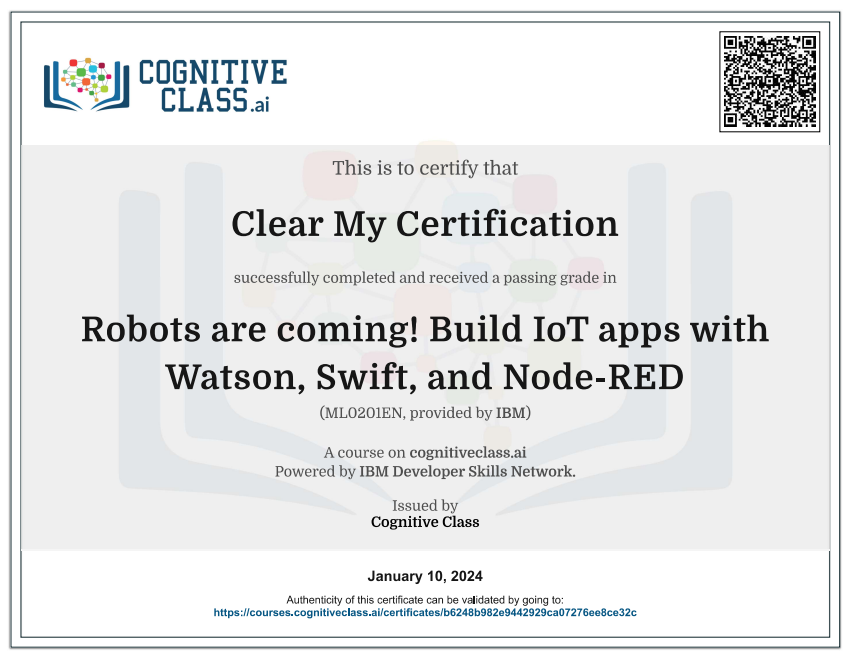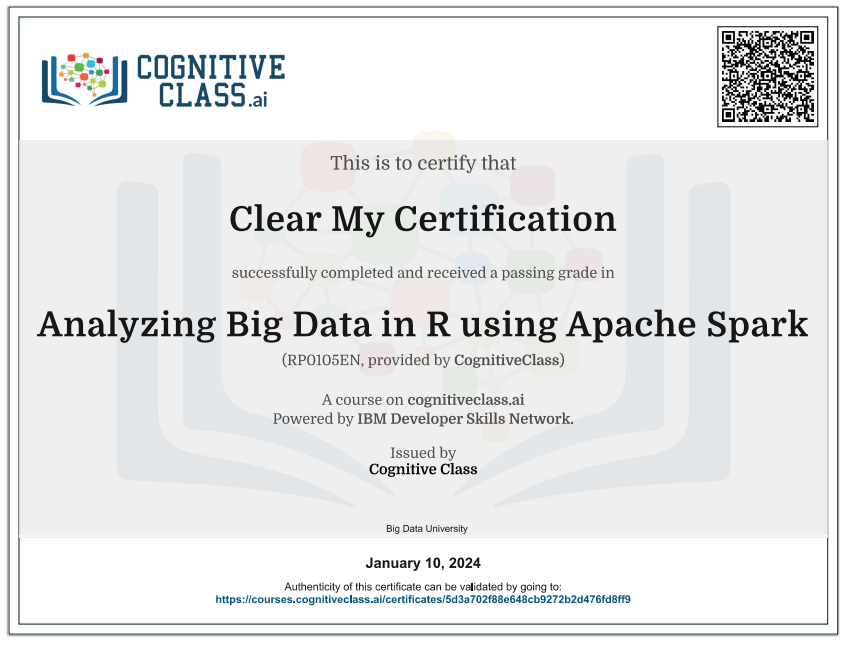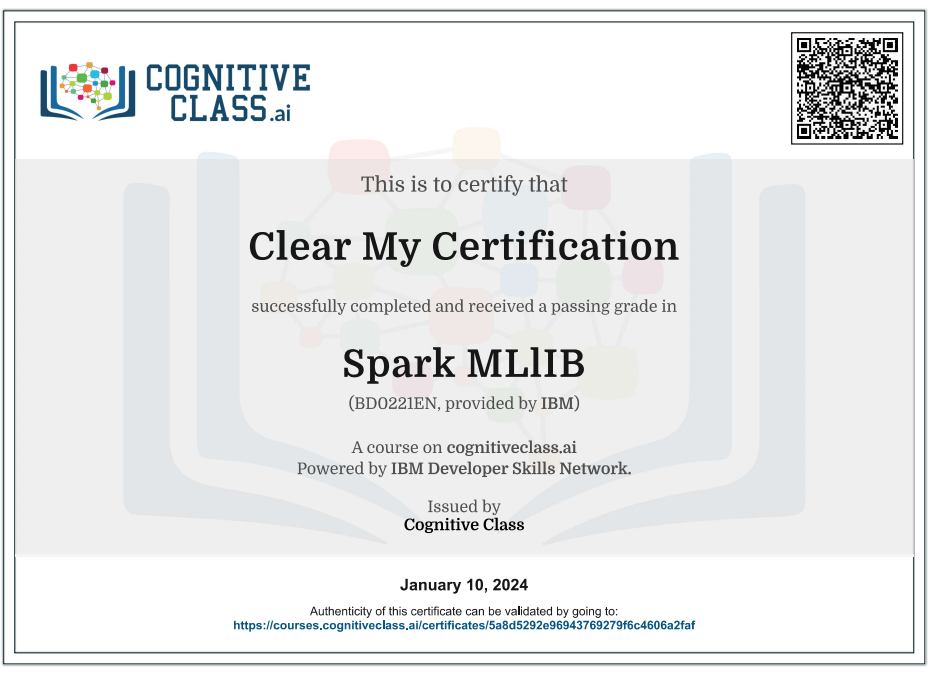Enroll Here: Robots are coming! Build IoT apps with Watson, Swift, and Node-RED Cognitive Class Exam Quiz Answers
Robots are coming! Build IoT apps with Watson, Swift, and Node-RED Cognitive Class Certification Answers

Lab 1: Read Temperature Data from an IoT Sensor Quiz Answers – Cognitive Class
Question 1: In Lab 1, what is the main purpose of the Internet of Things Platform Starter?
- To provide a boilerplate application in Node-RED
- To facilitate communication between the Node-RED instance running on the Raspberry Pi and the instance running on IBM Cloud
- To send data from an iOS device to Twitter
- To create a Cloudant database
Question 2: In Lab 1, where exactly does the Swift UI get the temperature data from?
- Directly from the temperature senson device
- From a node in the Node-RED flow
- From the Cloudant database
- From the IoT QuickStart
Question 3: What imported library is required for you to do CRUD operations on the Cloudant database in IBM Cloud?
- SwiftDBCloudant
- CloudantSwift
- SwiftyDB
- SwiftCloudant
Question 4: In Lab 1, why did you need two Node-RED flows?
- To get sensor data (flow 1) and then to send it to IBM Cloud (flow 2)
- To set up a Cloudant database (flow 1) and then send it IBM Cloud (flow 2)
- To get sensor data (flow 1) and then send it to the IoT Platform QuickStart (flow 2)
- None of these
Question 5: In which Node-RED node do you initially enter a device ID? In this lab, the device ID is from the virtual temperature sensor.
- IBM IoT App Out
- msg.payload
- IBM IoT App In
- GetCPUtemp
Lab 2: Add a Camera and Analyze Images Quiz Answers – Cognitive Class
Question 1: How is Watson Visual Recognition used by the Raspberry Pi in an IoT environment?
- Pictures taken by the Raspberry Pi camera are sent in bulk to the cloud and matched against existing pictures.
- Pictures taken by the Raspberry Pi camera are matched against existing pictures on the Raspberry Pi. The result is communicated to the cloud.
- Single pictures taken by the Raspberry Pi camera are sent to the cloud and processed by the deep learning network trained on existing pictures.
- Pictures taken by the Raspberry Pi camera are minimized on the Raspberry Pi before being sent to the cloud for comparison with existing pictures.
Question 2: The Visual Recognition service uses machine learning to recognize and classify visual content.
- True
- False
Question 3: MQTT cannot be used to pass data through firewalls.
- True
- False
Question 4: What action does the following Swift code perform?
DispatchQueue.main.asyncAfter(deadline: .now() + .seconds(10), execute: {
// Put your code which should be executed with a delay here
NSLog(“Read doc: 10 sec”)
self.imageFromDb.image = self.fetchedImage as UIImage
})
- Updates the Cloudant database with a new picture
- Shows a picture on a mobile device
- Creates buttons in your mobile UI
- Sends a picture to the Visual Recognition service
Question 5: In Node-RED, output nodes have the logo on the left side of the node.
- True
- False
Lab 3: Connect Your App to an iRobot and Smartphone Quiz Answers – Cognitive Class
Question 1: Which one of the following SDKs helps to simplify how you use cognitive services with Swift applications?
- Text-to-speech-swift
- Watson-Developer-Cloud SDK for iOS
- SwiftyJSON SDK
- IBM Cloud Services SDK for iOS
Question 2: What’s the purpose of the WeatherData.swift file?
- Adds the encoding for the network
- Connects the Text to Speech service to the iRobot
- Manages the connectivity to the Text to Speech service
- Manages the connectivity to the Weather Company Data service
Question 3: The Watson IoT Platform starter automatically deploys and connects which of these services. Select all that apply.
- Watson IoT Platform
- Weather Company Data service
- IBM SDK for Node.js for IBM Cloud
- IBM Cloudant for IBM Cloud
Question 4: To manipulate JSON, you added which framework to the XCode project?
- SpeechToTextV1.framework
- RestKit.framework
- SwiftyJSON.framework
- BMSCore.framework
Question 5: What additional data can you find in the Weather Data JSON?
- Conditions for playing golf
- Conditions for skating
- Conditions for hiking
- Conditions for swimming
- Conditions for running
Robots are coming! Build IoT apps with Watson, Swift, and Node-RED Final Exam Answers – Cognitive Class
Question 1: Which of the following data types can be be sent from an IoT sensor to the cloud for further processing? Select all that apply.
- Temperature
- Humidity
- Air pressure
- Seismometer data
- Text
Question 2: What is the lightweight protocol that is used for communication between a Raspberry Pi device and a cloud application?
- TCP/IP
- HTTP
- MQTT
- MSP
Question 3: Which Watson services can you use to build a voice user interface to access IoT devices?
- Speech to Text
- Real-time Audio conversion
- Text to Speech
- Voice routing over the Internet
Question 4: You typically need to install a node package to get Cloudant database nodes in Node-RED.
- True
- False
Question 5: How does BM Watson Visual Recognition determine what’s in an image?
- By analyzing the file names of images
- By deciding what categories the image and the parts of an image fall into
- By reading what users post on social media about an image
- By querying the user who ted the image
Question 6: In this course, how did you connect the Raspberry PI to the iRobot?
- MQTT
- The iRobot serial port
- HTTP
- ICMP
Question 7: IBM Cloudant is an example of which of the following service types? Select all that apply.
- MBaaS
- PaaS
- SaaS
- DBaaS
Question 8: What action does the following code perform?
iotfSession.send(BEEP_MSG.data(using: String.Encoding.utf8, allowLossyConversion: false),
topic: CMD_TOPIC,
qos: MQTTQosLevel.exactlyOnce,
retain: false)
- Sends a dock command to the iRobot
- Specifies what encoding to use
- Sends a command over an MQTT connection
- Sends a command to a smartphone
Question 9: What method can you use to extend the functionality of Raspbian Jessie?
- npm
- Configure it with apt-get commands
- Download nodes from the Node-RED community
- CocoaPods
Question 10: You can store pictures from a camera or from the Internet by using a Cloudant database.
- True
- False
Introduction to Robots are coming! Build IoT apps with Watson, Swift, and Node-RED
Building Internet of Things (IoT) applications using Watson, Swift, and Node-RED involves combining different technologies to create a comprehensive solution. Below are the steps you can follow to build IoT apps with these technologies:
1. Define the IoT Use Case:
- Identify the specific use case for your IoT application. Define what kind of data you want to collect from IoT devices and what insights or actions you want to derive from that data.
2. Select IoT Devices:
- Choose the IoT devices or sensors that are appropriate for your use case. Ensure that these devices can communicate data to your IoT application.
3. Setup Node-RED:
- Node-RED is a visual programming tool for wiring together IoT devices, APIs, and online services. Install and set up Node-RED on a server or a device that will act as a gateway for your IoT devices.
4. Connect IoT Devices to Node-RED:
- Use the appropriate protocols (e.g., MQTT, HTTP) to connect your IoT devices to Node-RED. Node-RED provides nodes (blocks) that make it easy to interface with various IoT devices.
5. Integrate Watson IoT Platform:
- IBM Watson IoT Platform helps you securely connect and manage IoT devices. Integrate the Watson IoT Platform with Node-RED to leverage its features such as device management, real-time data analysis, and insights.
6. Develop Swift Application:
- If you’re developing a mobile application, use Swift for iOS app development. Ensure that your Swift app can communicate with Node-RED or the Watson IoT Platform to send and receive data.
7. Implement Data Processing and Analytics:
- Use Node-RED to process and analyze the data coming from IoT devices. You can integrate Watson services, such as Watson Machine Learning or Watson Studio, for more advanced analytics and insights.
8. Implement Node-RED Flows:
- Create Node-RED flows to define how data should flow between devices, services, and applications. Use the visual programming interface to set up the logic for your IoT application.
9. Implement Cloud Services:
- Utilize cloud services, such as IBM Cloud or other cloud providers, to host and scale your IoT application. Ensure that your cloud infrastructure can handle the data volume and provide high availability.
10. Implement Security Measures:
- Implement security measures at every level of your IoT application. Secure communication between devices and the backend, and use proper authentication and authorization mechanisms.
11. Test and Debug:
- Test your IoT application thoroughly to ensure that data flows correctly, and devices are communicating as expected. Debug and optimize your Node-RED flows and Swift application.
12. Deploy and Monitor:
- Deploy your IoT application to production, and set up monitoring tools to keep track of device status, data flow, and system performance.
13. Iterate and Improve:
- Continuously iterate on your IoT application based on user feedback and changing requirements. Use insights gained from analytics to improve the efficiency and functionality of your application.
By combining the capabilities of Watson, Swift, and Node-RED, you can create a robust and scalable IoT application that efficiently processes data from devices, performs analytics, and provides valuable insights.
 Clear My Certification All Certification Exam Answers
Clear My Certification All Certification Exam Answers



